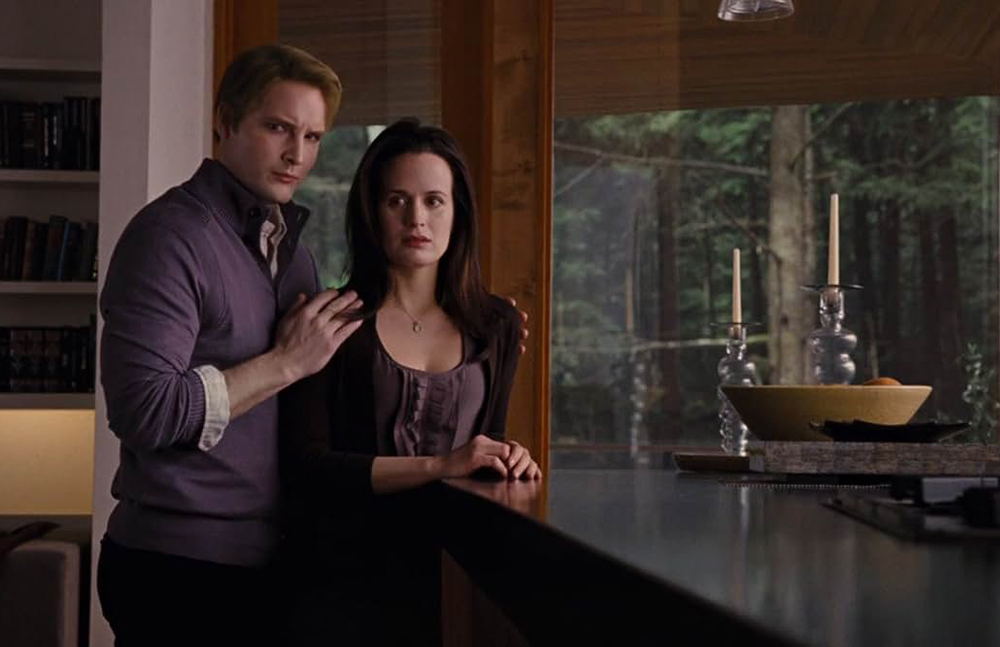Since the first “Twilight” film, released in 2008, audiences have been enamored with the romantic story between an ageless vampire, Edward Cullen (Robert Pattinson), and wishful teenager, Bella Swan (Kristen Stewart), whose romance exists under the watchful eye of protective parents, rival vampires, and a territorial pack of werewolves.
The prior three movies were devoted to different periods in their timeline—from their meeting and romance in the first film, to their breakup (at the hands of a protective Edward, who fears her life is in danger) in the second film, to the long-awaited third film, where Bella chooses Edward over rival Jacob Black (Taylor Lautner) (belonging to the werewolf tribe “Quileute”) as her romantic partner. Jacob’s love for Bella, and rivalry with Edward (the Cullen family is the sworn enemy of their tribe) fill out necessary details along the way, even if Bella’s choice of Edward were obvious all along.
Awkward, Real-Life Situations Present Themselves
“Breaking Dawn – Part 1” if told from the previews, appeared to revolve around Edward and Bella’s marriage and honeymoon, and a problematic pregnancy. And while the movie is predominantly about these things, it includes more, entertaining fans of the saga, as well as including more exposition and character development than previous films.
The wedding of Bella to Edward takes up a good part of the opening, with wedding preparations, invitations, and family dysfunction lining the festivities. While those with a soft spot for romance will enjoy the wedding, the after-events and toasts by various parties are markedly odd, lacking, and sometimes downright excruciating. Purposeful or not, this sets the film in a more realistic light, especially in terms of criticisms of the franchise deriding the naivety and fantasy of a teenage girl marrying a vampire. It feels awkward, and therefore it feels real.
Act two of the film, the honeymoon, is quickly cut short, as a life and death situation presents itself–Bella finds herself pregnant after her first night with Edward—and the vampire baby is slowly killing her.
The Love Triangle Resolves Itself

As this is transpiring, we get a better look at Jacob than we have previously, and the increasing dissatisfaction he finds with attempting to blend in with his tribe. Others, such as assumed-leader Sam, are content with following tribe rules with unwavering attention, and “imprinting” on another—giving one’s soul to another for life–a practice Jacob finds disgusting. “They’re not even themselves anymore…yet their genes tell them they’re happy.”
The point is not missed that Jacob’s distaste with this tradition may lie more in his unrequited feelings for Bella than the practice itself.
As the situation becomes more dire, and Bella’s death seems more and more certain, both male leads show predictable emotions, yet do so with rather good acting. You understand why Edward is concerned, even if it is selfish (his fear of losing Bella), and Jacob’s concern as well (his inability to admit that he has, in fact, lost her. Ironically, the only problem with underacting in this film seems to lie with Stewart—she accepts whatever comes her way, both joy and gloom, with unremarkable complacency).
Paves the Way for ‘Breaking Dawn – Part 2’
Lautner, in particular, espouses his character’s traits and faults to the next level—we are to understand he opposes greatly Bella’s marriage and life with Edward because he’s an evil vampire. However, as we understand Edward cares for Bella equally greatly and is not evil, Jacob’s intentions become more clear: he despises Edward because he has won Bella’s love and perhaps worse—he was never really a consideration.
The ending, which will not be spoiled here for those who have not yet seen the film, will doubtless please many fans, and pave the way for “Breaking Dawn – Part 2” and the end of the series. It includes action, drama, and, thankfully, a break from the “Vitori” vampire plotline that plauged other installments.
While not a standalone film in any way (prior knowledge of the series is basically assumed going into this movie), it does answer long-sought questions, and finally puts to rest the penultimate will-they-won’t-they question of the series: will Edward finally honor Bella’s wish and turn her into a vampire?
1 Comment
Pingback: » The Twilight Saga: Breaking Dawn – Part 2 (PG-13)